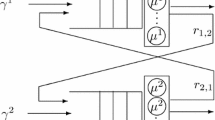Abstract
The qualitative behavior of open multiclass queueing networks is currently a topic of considerable activity. An important goal is to formulate general criteria for when such networks possess equilibria, and to characterize these equilibria when possible. Fluid models have recently become an important tool for such purposes. We are interested here in a family of such models, FIFO fluid models of Kelly type. That is, the discipline is first-in, first-out, and the service rate depends only on the station. To study such models, we introduce an entropy function associated with the state of the system. The corresponding estimates show that if the traffic intensity function is at most 1, then such fluid models converge exponentially fast to equilibria with fixed concentrations of customer types throughout each queue. When the traffic intensity function is strictly less than 1, the limit is always the empty state and occurs after a finite time. A consequence is that generalized Kelly networks with traffic intensity strictly less than 1 are positive Harris recurrent, and hence possess unique equilibria.
Similar content being viewed by others
References
F. Baskett, K.M. Chandy, R.R. Muntz and F.G. Palacios, Open, closed and mixed networks of queues with different classes of customers, J. ACM 22 (1975) 248–260.
M. Bramson, Instability of FIFO queueing networks, Ann. Appl. Prob. 4 (1994) 414–431.
M. Bramson, Instability of FIFO queueing networks with quick service times, Ann. Appl. Prob. 4 (1994) 693–718.
M. Bramson, Two badly behaved queueing networks,Stochastic Networks, IMA Volumes in Mathematics and its Applications, Vol. 71 (Springer, New York, 1995) pp. 105–116.
H. Chen, Fluid approximations and stability of multiclass queueing networks I: work-conserving disciplines, Ann. Appl. Prob., to appear.
H. Chen and A. Mandelbaum, Discrete flow networks: bottleneck analysis and fluid approximations, Math. Oper. Res. 16 (1991) 408–446.
H. Chen and A. Mandelbaum, Discrete flow networks: diffusion approximations and bottlenecks, Ann. Prob. 19 (1991) 1463–1519.
H. Chen and H. Zhang, Stability of multiclass queueing networks under FIFO service discipline, submitted to Math. Oper. Res.
J. Dai, On the positive Harris recurrence for multiclass queueing networks, Ann. Appl. Prob. 5 (1995) 49–77.
J. Dai and T. Kurtz, A multiclass station with Markovian feedback in heavy traffic, Math. Oper. Res. 20 (1995) 721–742.
J. Dai and S. Meyn, Stability and convergence of moments of multiclass queueing networks via fluid models, IEEE Trans. Automat. Control 40 (1995) 1889–1904.
J. Dai and Y. Wang, Nonexistence of Brownian models for certain multiclass queueing networks, Queueing Systems 13 (1993) 41–46.
V. Dumas, Unstable cycles in fluid Bramson networks, preprint.
S. Foss and A. Rybko, Stability of multiclass Jackson-type networks, preprint.
J.M. Harrison, Brownian models of queueing networks with heterogeneous customer populations,Stochastic Differential Systems, Stochastic Control Theory and their Applications, IMA Volumes in Mathematics and its Applications, Vol. 10 (Springer, New York, 1988) pp. 147–186.
J.M. Harrison, Balanced fluid models of multiclass queueing networks: a heavy traffic conjecture,Stochastic Networks, IMA Volumes in Mathematics and its Applications, Vol. 71 (Springer, New York, 1995) pp. 1–20.
J.M. Harrison and V. Nguyen, The QNET method for two-moment analysis of open queueing networks, Queueing Systems 6 (1990) 1–32.
J.M. Harrison and V. Nguyen, Brownian models of multiclass queueing networks: current status and open problems, Queueing Systems 13 (1993) 5–40.
F.P. Kelly, Networks of queues with customers of different types, J. Appl. Prob. 12 (1975) 542–554.
F.P. Kelly,Reversibility and Stochastic Networks (Wiley, New York, 1979).
S.H. Lu and P.R. Kumar, Distributed scheduling based on due dates and buffer priorities, IEEE Trans. Automat. Control 36 (1991) 1406–1416.
S. Meyn, Transience of multiclass queueing networks, submitted to Ann. Appl. Prob.
I.P. Natanson,Theory of Functions of a Real Variable, Vol. 1 (Ungar, New York, 1964).
M.I. Reiman, Open queueing networks in heavy traffic, Math. Oper. Res. 9 (1984) 441–458.
S. Rybko and A. Stolyar, Ergodicity of stochastic processes that describe the functioning of open queueing networks, Problems Inform. Trans. 28 (1992) 3–26; (in Russian).
A. Stolyar, On the stability of multiclass queueing networks,Proc. 2nd Conf. on Telecommunication Systems — Modeling and Analysis, Nashville (1994) pp. 1020–1028.
Author information
Authors and Affiliations
Additional information
1991Mathematics Subject Classification, 60K25, 68M20, 90B10. Partially supported by NSF Grant DMS-93-00612.
Rights and permissions
About this article
Cite this article
Bramson, M. Convergence to equilibria for fluid models of FIFO queueing networks. Queueing Syst 22, 5–45 (1996). https://doi.org/10.1007/BF01159391
Received:
Revised:
Issue Date:
DOI: https://doi.org/10.1007/BF01159391




